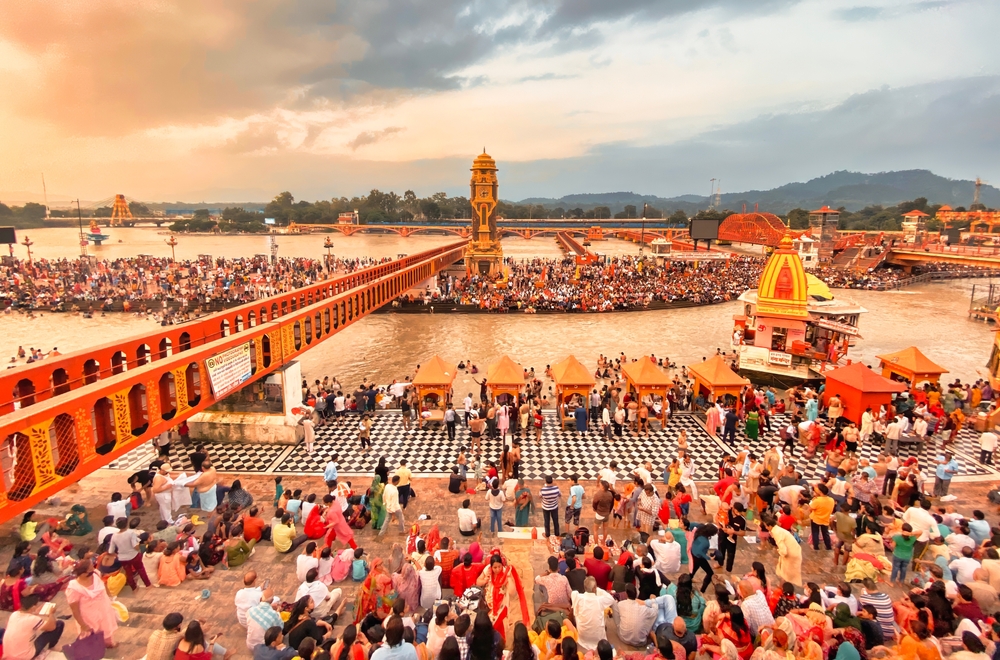‘Spiritual Tourism on a growth trajectory in India’: KPMG and PHDCCI report

KPMG in India and PHDCCI have released a report titled – “Sacred journeys: Unfolding the evolution and growth of pilgrimage and spiritual tourism in India” at PHDCCI’s 1st Global Spiritual Tourism Conclave. This report delves into the primary motivators behind pilgrimage and spiritual tourism, its economic ramifications, and the challenges and prospects it offers to destinations. Given the anticipated growth in India’s spiritual tourism, it’s crucial to understand the push and pull factors of different segments of pilgrims and provide tailor made solutions to support outreach.
Recognising the risks and sensitivities linked to pilgrimage tourism is equally vital, ensuring that proposed solutions foster respectful, sustainable, and mutually beneficial interactions between visitors and host communities.
Key highlights from the report:
- Potential of religious and spiritual tourism in the country – Post pandemic, spiritual tourism has taken centre stage with a significant increase in the number of travellers worldwide. For instance, religious tourism is a substantial driver of employment and economic activity both on a global scale and within India.
- Evolution of religious tourism – The concept of religious tourism is evolving, to meet the changing interests and values of modern travellers and reflects a broader shift towards more meaningful, responsible, and transformative travel experiences.
- Digital Influence on selection of sites – Modern trends in religious tourism in India reflect the intersection of tradition with contemporary practices and technology. Increased digital influence and an increase in positive reviews of travel bloggers has positively impacted the surge of religious tourism in India.
- Digital pilgrimages and virtual reality – Especially relevant during COVID-19 pandemic, virtual pilgrimages have gained popularity. In post pandemic era, inclination to travel became a must for every travel enthusiast. Live streaming of religious ceremonies, online darshans and 360-degree virtual tours allow devotees to participate remotely. Post the pandemic there is a rise in footfall of spiritual travellers. Many pilgrims combine religious visits with medical treatments or wellness retreats. Ayurvedic centres, yoga retreats and spiritual healing practices are integrated into religious tourism offerings.
- Better connectivity and supporting Infrastructure – The improved physical accessibility to destinations, Ecosystem of travel and facilities like hotel to stay, amenities, tours and travel packages have helped visitors in making impromptu decision to travel to any destination.
- Segments of pilgrimage tourism – Identifying different categories of pilgrims and acknowledging unique needs of various groups is vital for enhancing the pilgrimage experience, managing resources effectively, and promoting sustainable tourism practices. Pilgrimage tourism can be broadly categorised into three segments of believers — explorers, solo travellers, and mass organised pilgrims.
Solutions- Increasing outreach and sharing knowledge of common history:
- Holistic development of religious sites – With the emergence of new traveller segments seeking unique and offbeat experiences, there is an opportunity to integrate religious tourism with other forms of tourism. By combining adventure and wellness tourism at religious sites, these destinations can be promoted as holistic travel experiences. This approach not only enhances the appeal of religious sites but also diversifies tourism offerings, catering to a broader range of travellers looking for immersive and meaningful journeys.
- Outreach for hidden gems/ lesser-known pilgrim Destinations – Developing under the radar sites involves a comprehensive approach to boost their visibility and appeal to a broader tourist demographic. This can be done by:
- Research and documentation – Thorough research and documentation of a site’s historical and spiritual significance is a foundational step, crucial for building a compelling narrative that can be shared with potential visitors.
- Preservation and restoration – Improving physical infrastructure accessibility around these sites through careful preservation and restoration efforts is key to enhancing visitor experience.
- Local community involvement – Engaging local communities in the development process is vital for fostering sustainable tourism practices.
- Educational programmes – Implementing educational programmes like guided tours, workshops, or lectures about a site’s history and spiritual significance can attract tourists with a keen interest in cultural and spiritual enrichment.
- Carrying capacity based development initiatives of religious places – To address the challenges of overcrowding at India’s renowned spiritual destinations, a comprehensive approach encompassing destination-level measures, precinct-level strategies, and shrine-specific actions is essential. These measures aim to alleviate strain on local resources, preserve the sanctity of the shrines, and enhance the spiritual experience for all visitors.
- Digital intervention – Adopting AI and predictive analytics, with collaboration among local authorities, religious institutions, and technology providers, can cater to promotion of the hidden gems of cultural, spiritual and religious importance in India while establishing sustainable practices for development of pilgrimage tourism sites.
Vivek Agarwal, Partner and Lead – Industrial and Infrastructure Development, KPMG in India said, “Worldwide, India is recognised for its rich array of pilgrimage sites, spiritual landmarks, and ancient healing practices. As the demand for spiritual tourism grows, it is essential to promote comprehensive, holistic, and sustainable development of these sites. This approach will not only enrich the spiritual experiences of pilgrims but also preserve the sanctity of these destinations”.
Aalap Bansal, Partner – Industrial & Infrastructure Development Advisory (IIDA), KPMG in India said, “The evolution of pilgrimage and spiritual tourism in India mirrors broader trends in the tourism industry. Digital tools and social media have significantly expanded the reach and accessibility of spiritual practices. However, challenges such as over-tourism, strained infrastructure, disruptions to local communities, and cultural dilution highlight the need for a holistic and sustainable approach to site development. Utilizing digital tools and diversifying tourism offerings are essential for managing growth and addressing these issues effectively”.
In summary, pilgrimage and spiritual tourism present substantial opportunities for economic advancement and cultural exchange. Adopting a sustainable and inclusive approach to development can enable destinations to leverage these opportunities while safeguarding their cultural and religious heritage for future generations.


Comments are closed.